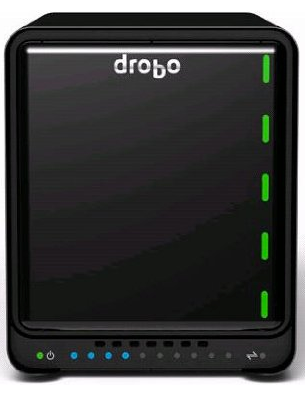Drobo 5N: Easy, inexpensive network-attached storage

Over the past few months TUAW has highlighted some of the storage products made by Drobo. First, we took a look at the five-drive Drobo 5D and found it to be a fast and very capable storage device. Next, we had a look at the Drobo mini, which uses four 2.5-inch drives to provide a compact and still speedy solution for those who want expandable redundant storage at a decent price. Today, we'll be looking at a Drobo network-attached storage solution, the Drobo 5N (US$599.99, available online for about $515).
Specifications
Dimensions: 5.9 x 7.3 x 10.3 inches (150.3 x 185.4 x 262.3 mm)
Weight: 8.5 lbs. (3.86 kg) without drives or power supply
Power: External AC Adapter, AC Input -- 100-240VAC~2A, 50-60Hz; DC Output -- 12V, 12.5A, 150W max
Interface: Gigabit Ethernet (1 port)
Capacity: Varies depending on the capacity of drives inserted into the five bays and whether single- or dual-drive redundancy has been enabled.
Amazon Buyer Ratings: 3.9 out of 5 stars with 112 reviews
RAID capabilities: Uses Drobo proprietary BeyondRaid setup. Can be set up for either single- or double-drive failure redundancy
Enclosure Specifics: Not rack-mounted, the Drobo 5N is a self-contained unit
Design
As we've noted in earlier reviews of Drobo equipment, the company's BeyondRaid technology makes it simple to set up a RAID mass-storage device. Drives don't have to be of the same capacity or even made by the same manufacturer -- instead, you can pop out older, smaller drives when you want and put in newer, faster and larger-capacity drives to keep increasing the capacity of the array.
Setting up the device with dual-drive redundancy limits the available capacity of the Drobo 5N, but definitely gives it the ability to withstand multiple drive failures without a hiccup. It's that extra bit of insurance against data loss in those one-in-a-million cases that seem to happen more frequently than that...
This unit looks identical to the Drobo 5D with the exception of the back -- where there are multiple interfaces on the rear of the Drobo 5D, here there's just a single Gigabit Ethernet port. You can use that to connect directly to a Mac (that's what I did) or to a wired network. For those situations where you want to share data with others in an office, you'll want to connect it to your fast Ethernet network. Like the Drobo 5D, this unit has an easily accessed slot on the bottom of the device for adding an mSATA SSD for caching purposes.
Like the other Drobo family members, the Drobo 5N uses the Drobo Dashboard application to allow configuration and setup of the device. The app recognized the 5N almost immediately, and allowed me to set up shares and users easily -- that's another difference with this NAS device that is not available with the single-user devices.
The other big difference with the Drobo 5N is that it can run apps that have been written specifically for the device. Some of those apps include CrashPlan (back up locally and in the cloud), Elephant drive (cloud backup), FireFly open-source media server for iTunes, Modoboa Mailserver, MediaTomb (free UPnP media server), MySQL, Plex media server and Transmission (BitTorrent client).
Functionality/Benchmarks
Setup of the Drobo 5N was a piece of cake. Without reading the directions (yes, I do have previous experience with Drobo products), I was able to install the three 1 TB, one 2 TB and one 3 TB drives into the carrier-less drive bays, plug it into my Ethernet router and fire it up. The variety of drives used shows you how the Drobo design makes it easy to mix up drive capacities and even manufacturers. The Drobo Dashboard app was already on my MacBook Pro from previous reviews, and it found the array quickly. The Drobo 5N supports CIFS/SMB, but more importantly, it supports Apple Filing Protocol (AFP).
For the purposes of testing external drives and RAID arrays, we traditionally use the Intech SpeedTools QuickBench 4.0 app to run multiple cycles of read/write tests. In this case, both the Mac that was running QuickBench (MacBook Pro with Retina display) and the array were connected via Gigabit Ethernet. The MacBook Pro was using an Apple Thunderbolt to Gigabit Ethernet adapter; the Drobo 5N has built-in Gigabit Ethernet; and the two were connected via a Linksys Gigabit Ethernet router. The Drobo 5N did not have the optional mSATA SSD installed for caching, so the benchmark results you see here are on the low end of what the device is capable of doing.
To ensure accuracy in testing, I performed a 100-cycle complete test. This subjects the drive to sequential and random read and write tests with file sizes from 4K to 100 MB, then graphically or textually displays that information to show the "sweet spots" for a specific drive or array. For example, if your work involves shuffling around a lot of very large files, you'll probably want a drive that has peak read/write speeds for files around your average file size. Here are the test results:
Sequential Read: 48.452 MB/Sec (140.504 MB/Sec for Drobo 5D connected via Thunderbolt)
Sequential Write: 12.398 MB/Sec (93.245 MB/Sec for Drobo 5D connected via Thunderbolt)
Random Read: 51.344 MB/Sec (116.435 MB/Sec for Drobo 5D connected via Thunderbolt)
Random Write: 21.866 MB/Sec (70.410 MB/Sec for Drobo 5D connected via Thunderbolt)
Large Read: 109.947 MB/Sec (341.327 MB/Sec for Drobo 5D connected via Thunderbolt)
Large Write: 71.205 MB/Sec (282.060 MB/Sec for Drobo 5D connected via Thunderbolt)
Extended Read: 107.690 MB/Sec (255.953 MB/Sec for Drobo 5D connected via Thunderbolt)
Extended Write: 46.833 MB/Sec (262.864 MB/Sec for Drobo 5D connected via Thunderbolt)
As you'll note, the results are slower across the board for the network-attached Drobo 5N than for a Thunderbolt Drobo 5D -- but that's quite expected as these are two different animals. The Drobo 5N is all about sharing data, and in that it excels. The drive can act as a "poor man's server" for small offices, complete with the ability to set permissions and users. Through the use of Drobo Apps, the device can be an email or database server as well. Sure, a Drobo 5N doesn't provide all of the many capabilities of a "real" server, but for a small business, the combination of large, expandable and redundant storage, security and apps could be a relatively low-cost and easily supported solution.
I didn't mention some of the other publicly supported Drobo apps, but the ability to run MySQL, PHP and Apache as well could make this an excellent WordPress server for a serious blogger.
The bottom line? If you need large, fast storage for one person, then the Thunderbolt-connected Drobo 5D is an excellent solution. But if you want an easy-to-setup, easily supported network-attached storage solution, the Drobo 5N is the device you want to buy. Price-wise, you're looking at a really reasonable solution, too. At Drobo's online prices, a 5N with five 2 TB drives (7.26 TB of usable shared capacity) runs US$1,099. Buy the same device on Amazon at $490 and add five Western Digital 2 TB NAS hard drives for $98.95 each, and you're looking at less than $1,000.
Drobo offers a standard two-year warranty for the device, with a 3-year extended warranty and enhanced support available for a fee.
Conclusion
Drobo's product line has matured, and for the better. We've tested all three of the professional line -- the Drobo Mini, the Drobo 5D and now the network-attached Drobo 5N -- and all of the devices are stoutly built, easy to install and relatively fast. While the Drobo 5N won't break any speed records as an Ethernet-attached device, it's still quite speedy and a very reasonably priced NAS solution. The addition of Drobo Apps adds a level of flexibility that makes the Drobo 5N a no-brainer for small business shared storage. I honestly don't know how any vendor can make network-attached storage more simple to set up or inexpensive to buy than Drobo has with the 5N.
Rating: 3-1/2 stars out of 4 stars possible


